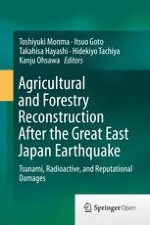14.1 Background and Purpose of Research
14.2 Materials and Methods
14.2.1 The Ostriches Examined
14.2.2 Handling and Feeding Methods
14.2.3 Study Method
Recapture day | Sex | Date examined | Days from recapture to examination | Age in months |
|---|---|---|---|---|
January 12, 2012 | Male | March 27, 2012 | 74 | 79 |
January 13, 2012 | Male | February 16, 2012 | 34 | 66 |
January 13, 2012 | Male | October 26, 2012 | 287 | 180 |
January 13, 2012 | Female | February 8, 2013 | 392 | 60–84 |
January 13, 2012 | Male | February 21, 2013 | 405 | 60–84 |
May 29, 2012 | Male | May 25, 2013 | 361 | Unknown |
14.2.4 Body Measurement and Collection of Samples
14.2.5 Radiation Measurement
14.3 Research Findings
14.3.1 Ambient Dose
-
March 16, 2012: 4.6 μSv/h
-
March 27, 2012: 4.0 μSv/h
-
October 24, 2012: 3.4 μSv/h
-
February 8, 2013: 2.3 μSv/h
-
February 21, 2013: 2.4 μSv/h
-
May 25, 2013: 2.0 μSv/h
